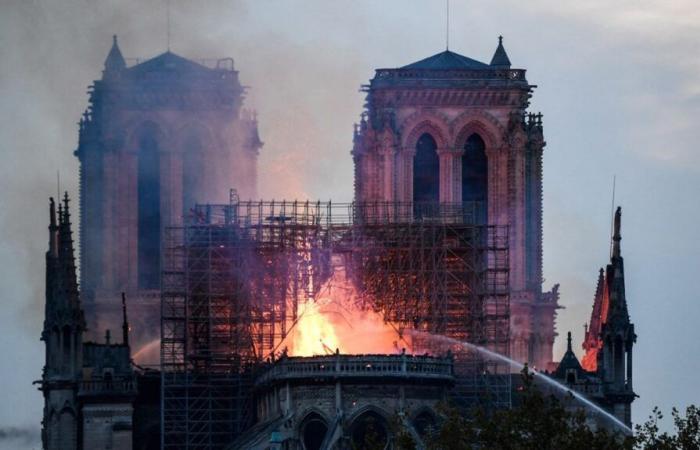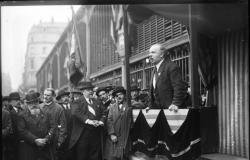
The origin of the cathedral fire in 2019 is still not clearly identified. And it will not be when the monument reopens to the public on December 8.
A brand new cathedral, but which retains its share of mystery. Notre-Dame de Paris has regained its splendor and the President of the Republic, Emmanuel Macron, comes to see it in person one last time, Friday November 29, before the official reopening of the building to the public on December 8. A restored and luminous cathedral, but which has not revealed all its mysteries.
More than five years after the devastating fire of April 2019, the causes of this disaster are still not known. “Using the expertise will take several more months,” warns the Paris prosecutor's office, contacted by franceinfo at the end of November. For the moment, no indictment has taken place in this case.
Judicial investigation has been opened against June 26, 2019on the grounds of “unintentional damage by fire through a clearly deliberate violation of an obligation of prudence or safety”, but judicial time is not the same as media time. In detail, “all the expertise on the seals has been returned” now, argues the prosecution, but the investigations are not finished: a 3D modeling of the flame “as it was filmed and photographed” is in progress. This modeling should make it possible to “determine as best as possible the origin of the fire” by confronting it with the different hypotheses put forward on the causes of the start of the fire, according to the same source.
Quickly after the tragedy, the accidental track was favored by thehe Paris public prosecutor at the time, Rémy Heitz. “Nothing goes in the direction of a voluntary act”he declared in the first days following the fire, then evoking a poorly extinguished cigarette butt or an electrical malfunction. And for good reason, several workers admitted to the police that they had smoked on the construction site despite the ban. Butts were also found on the site. “In no case can a poorly extinguished cigarette butt be the cause of the fire at Notre-Dame de Paris,” at the time vehemently defended Marc Eskenazi, spokesperson for the company Le Bras Frères, responsible for installing the scaffolding around the spire of the cathedral.
The area where the fire started is known to investigators. The flame started from the attic, more precisely from a horizontal beam of the frame, at the level of “the sand pit of the gutter wall of the choir, at the south-east corner of the transept crossing”, had learned, in 2022, France Télévisions from a judicial source. A perimeter at this area, around the south transept and the choir had then been set up in the attic: the area, called “scarlet” by the authorities, was prohibited from access, except for investigators, recalls the Paris prosecutor's office.
In December 2022, the last remaining lead and rubble from this “scarlet” area were collected in 21 bags and then moved to begin a search for clues. The entire fire starting zone and all the elements which could have been trapped under the molten lead cover are therefore now exploited. Enough to allow, on July 6, 2023, the lifting of seals on this sensitive area, traces the judicial institution.
After the fire, the revelation, by The Chained Duck and Marianne, of the presence in the arrow of electrified bells, whose cables were located in the attic, had triggered numerous speculations. The thesis of a problem with the electrification device of these bells was then studied. This avenue has not been ruled out five years later. Beginning March, investigators from the criminal brigade, experts and investigating judges went to Notre-Dame to “become aware of the conditions in which the work was carried out” et “visualize the electrical system powering the bells in the spire and the electrical cabinet”, The Paris prosecutor's office is still unfolding.
The trail of an electrical accident following a “hot spot” on the site was quickly swept away by the CEO of the Le Bras Frères group. No “hot spot” operations, such as welding or grinding which would cause sparks, were carried out on the day of the fire and the 12 workers present on site were setting up the scaffolding with, as tools, “hammers and wrenches of 22“, he then explained. Contacted by franceinfo before the reopening of Notre-Dame, the business manager, who has become a civil party in this case, does not wish to comment on the procedure and recalls that the progress of the investigations had made it possible to “to silence all those who had attacked [l’entreprise] at the time.”
As for the alarm system, significant flaws have been identified. Without explaining the fire, they still allow us to understand the extent of the disaster. On the evening of the disaster, a first fire alert was given at 6:20 p.m., but did not make it possible to detect the start of the fire. Alerted by the security PC, an agent went to check on site, but was unable to get to the right place. A second alarm went off just 23 minutes later. The same security agent this time went to the roof structure to discover the presence of flames. A delay of a few minutes which could have had immense repercussions for the Gothic building, ravaged by flames in a few hours.





